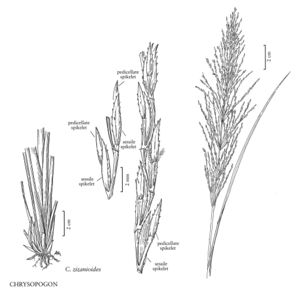Difference between revisions of "Chrysopogon zizanioides"
FNA>Volume Importer |
FNA>Volume Importer |
||
| Line 19: | Line 19: | ||
-->{{Treatment/Body | -->{{Treatment/Body | ||
| − | |discussion=<p | + | |discussion=<p>Chrysopogon zizanioides, which used to be included in Vetiveria, is native to river banks and flood plains in the south Asian tropics and subtropics, but it has been deliberately established in the warmer areas of the United States. It grows in a variety of soils, from heavy clays to dune sand, and will tolerate windy coastal conditions.</p><!-- |
| − | --><p>Hedges of | + | --><p>Hedges of Chrysopogon zizanioides can control soil erosion or restore eroded land. Once established, they are effective even in desert areas subject to flash flooding. The deep root system reaches water far below the surface and prevents the plants from being washed away while the dense, aboveground growth traps silt and sediment. Because C. zizanioides does not spread vegetatively and many cultigens have low or no seed production, contour hedges can be planted around cultivated fields or engi-hedges can be planted around cultivated fields or engineering structures without fear of invasion. Essential oils from the aromatic roots are sometimes used as perfume, and numerous biocidal effects are reported. For current information on uses of Chrysopogon zizanioides, see http://www.vetiver.org/.</p> |
|tables= | |tables= | ||
|references= | |references= | ||
| Line 36: | Line 36: | ||
|basionyms= | |basionyms= | ||
|family=Poaceae | |family=Poaceae | ||
| + | |illustrator=Linda A. Vorobik and Annaliese Miller | ||
|reference=None | |reference=None | ||
|publication title= | |publication title= | ||
|publication year= | |publication year= | ||
|special status= | |special status= | ||
| − | |source xml=https:// | + | |source xml=https://bibilujan@bitbucket.org/aafc-mbb/fna-data-curation.git/src/314eb390f968962f596ae85f506b4b3db8683b1b/coarse_grained_fna_xml/V25/V25_1543.xml |
|subfamily=Poaceae subfam. Panicoideae | |subfamily=Poaceae subfam. Panicoideae | ||
|tribe=Poaceae tribe Andropogoneae | |tribe=Poaceae tribe Andropogoneae | ||
Revision as of 16:16, 30 October 2019
Plants perennial; cespitose, not stoloniferous. Culms 1-3 m, not branched, not woody. Sheaths glabrous, keeled; Ligules 0.3-1.5 mm, of hairs; blades 23-140 cm long, 2.5-13 mm wide, flat or folded, mostly glabrous but the adaxial surfaces usually pilose basally. Panicles 16-33 cm long, 2.5-9 cm wide, with many branches; branches 5.5-12 cm, ascending, naked basal portions 1-4 cm, terminating in a rame; rames to 10 cm, with 5-13 spikelet pairs and a terminal triplet. Sessile spikelets 3.8-6 mm (including the callus); calluses 0.6-0.8 mm, rounded, laterally ciliate basally, hairs 0.1-1.4 mm, white; lower glumes scabrous or setulose to spinulose distally, particularly on the veins, acute to acuminate; upper glumes setulose distally, particularly on the veins, without a dorsal fringe of hairs, muticous; upper lemmas muticous to awned, awns to 2(4.5) mm, straight. Pedicels 2.2-4.3 mm. Pedicellate spikelets 2.8-4.6 mm, staminate; glumes muticous; anthers 1.6-2 mm. 2n = 20.
Discussion
Chrysopogon zizanioides, which used to be included in Vetiveria, is native to river banks and flood plains in the south Asian tropics and subtropics, but it has been deliberately established in the warmer areas of the United States. It grows in a variety of soils, from heavy clays to dune sand, and will tolerate windy coastal conditions.
Hedges of Chrysopogon zizanioides can control soil erosion or restore eroded land. Once established, they are effective even in desert areas subject to flash flooding. The deep root system reaches water far below the surface and prevents the plants from being washed away while the dense, aboveground growth traps silt and sediment. Because C. zizanioides does not spread vegetatively and many cultigens have low or no seed production, contour hedges can be planted around cultivated fields or engi-hedges can be planted around cultivated fields or engineering structures without fear of invasion. Essential oils from the aromatic roots are sometimes used as perfume, and numerous biocidal effects are reported. For current information on uses of Chrysopogon zizanioides, see http://www.vetiver.org/.
Selected References
None.
